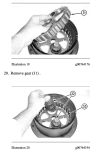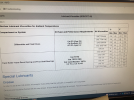nonprod
Active Member
Hello friends,
Maybe y'all can give me your opinions about recourse, in the ugly discoveries in my 304CR Final Drives.
Back story: 2006 machine, NAD04265, 4800 hours, no service history, 'normal' general significant abuse, etc. No travel issues in operation. When I acquired the machine I drained and refilled the FDs, the oil was old, ugly, smelled of cancer, etc, but I didn't find gear shrapnel or other grave items. I changed it to a fancy Redline 75W90, probably should've just put in the Cat Oil, but then I ran for 75 hours, and then sampled both drives, with attention to (sample) cleanliness, and sent them to the Peterson Lab in Eugene.
The come back with a number of notes:
1) Both drives quite elevated Iron, Calcium, Aluminum and Silicon, and they mention Chrome in the left.
2) Metal Flakes, they say non-magnetic more in the Right
3) Water (condensation) in the Left
The Cat note on the Left:
TRACE WATER DETECTED, APPEARS TO BE CONDENSATION. SILICON AND ALUMINUM INDICATE A HIGH DEGREE OF
DIRT CONTAMINATION. IRON AND CHROME ARE ELEVATED SUGGESTING INCREASED GEAR AND BEARING WEAR DUE
TO DIRT. CHECK FOR DIRT PACKING AROUND FINAL DRIVE AND INSPECT SEALS FOR ANY DAMAGE. CHANGE OIL AND
FLUSH COMPARTMENT TO REMOVE CONTAMINANTS. RESAMPLE IN 50 HRS.
And on the Right:
MORE SAMPLE HISTORY NEEDED TO ESTABLISH A NORMAL WEAR TREND. VISCOSITY IS HIGH. SILICON AND ALUMINUM (
TYPICALLY DIRT) LEVELS APPEAR HIGH AND COULD BE CAUSING ACCELERATED WEAR - IRON APPEARS ELEVATED.
OTHER READINGS APPEAR TO BE NORMAL. RECOMMEND TO CHANGE OIL IF NOT DONE YET. INSPECT FOR SOURCE OF
DIRT ENTRY INTO THE SYSTEM. CHECK FOR UNUSUAL PERFORMANCE, HEAT, NOISES, VIBRATIONS, FLUID LEVELS.
RESAMPLE IN 125 HOURS TO MONITOR.
SO TO THE QUESTION:
Despite not wanting to pull apart the final drives with the wrong tools, not enough light, in a muddy forest - clearly these things need to be flushed out. How am I to do this? Cat suggests essentially multiple oil changes, possibly with a lighter oil, alternated with some mild operation. I see some suggesting pouring diesel in there, running it back a forth, drain and then a couple of fresh oil changes, resample after another 50 hours... ...the problem I assume is getting any kind or solvent out of there, if not creating more damage to seals or whatever else...
Whadya think?
Pictured are the sample capfuls, the water contaminated one is obviously lighter, and the manual snaps of the components. I can see pulling the outer covers, but if the oil sneaks around back of the center plate around the center gear and through the side rack/pin gear, then the muck is also much deeper in.
TIA - gibbs
Maybe y'all can give me your opinions about recourse, in the ugly discoveries in my 304CR Final Drives.
Back story: 2006 machine, NAD04265, 4800 hours, no service history, 'normal' general significant abuse, etc. No travel issues in operation. When I acquired the machine I drained and refilled the FDs, the oil was old, ugly, smelled of cancer, etc, but I didn't find gear shrapnel or other grave items. I changed it to a fancy Redline 75W90, probably should've just put in the Cat Oil, but then I ran for 75 hours, and then sampled both drives, with attention to (sample) cleanliness, and sent them to the Peterson Lab in Eugene.
The come back with a number of notes:
1) Both drives quite elevated Iron, Calcium, Aluminum and Silicon, and they mention Chrome in the left.
2) Metal Flakes, they say non-magnetic more in the Right
3) Water (condensation) in the Left
The Cat note on the Left:
TRACE WATER DETECTED, APPEARS TO BE CONDENSATION. SILICON AND ALUMINUM INDICATE A HIGH DEGREE OF
DIRT CONTAMINATION. IRON AND CHROME ARE ELEVATED SUGGESTING INCREASED GEAR AND BEARING WEAR DUE
TO DIRT. CHECK FOR DIRT PACKING AROUND FINAL DRIVE AND INSPECT SEALS FOR ANY DAMAGE. CHANGE OIL AND
FLUSH COMPARTMENT TO REMOVE CONTAMINANTS. RESAMPLE IN 50 HRS.
And on the Right:
MORE SAMPLE HISTORY NEEDED TO ESTABLISH A NORMAL WEAR TREND. VISCOSITY IS HIGH. SILICON AND ALUMINUM (
TYPICALLY DIRT) LEVELS APPEAR HIGH AND COULD BE CAUSING ACCELERATED WEAR - IRON APPEARS ELEVATED.
OTHER READINGS APPEAR TO BE NORMAL. RECOMMEND TO CHANGE OIL IF NOT DONE YET. INSPECT FOR SOURCE OF
DIRT ENTRY INTO THE SYSTEM. CHECK FOR UNUSUAL PERFORMANCE, HEAT, NOISES, VIBRATIONS, FLUID LEVELS.
RESAMPLE IN 125 HOURS TO MONITOR.
SO TO THE QUESTION:
Despite not wanting to pull apart the final drives with the wrong tools, not enough light, in a muddy forest - clearly these things need to be flushed out. How am I to do this? Cat suggests essentially multiple oil changes, possibly with a lighter oil, alternated with some mild operation. I see some suggesting pouring diesel in there, running it back a forth, drain and then a couple of fresh oil changes, resample after another 50 hours... ...the problem I assume is getting any kind or solvent out of there, if not creating more damage to seals or whatever else...
Whadya think?
Pictured are the sample capfuls, the water contaminated one is obviously lighter, and the manual snaps of the components. I can see pulling the outer covers, but if the oil sneaks around back of the center plate around the center gear and through the side rack/pin gear, then the muck is also much deeper in.
TIA - gibbs









